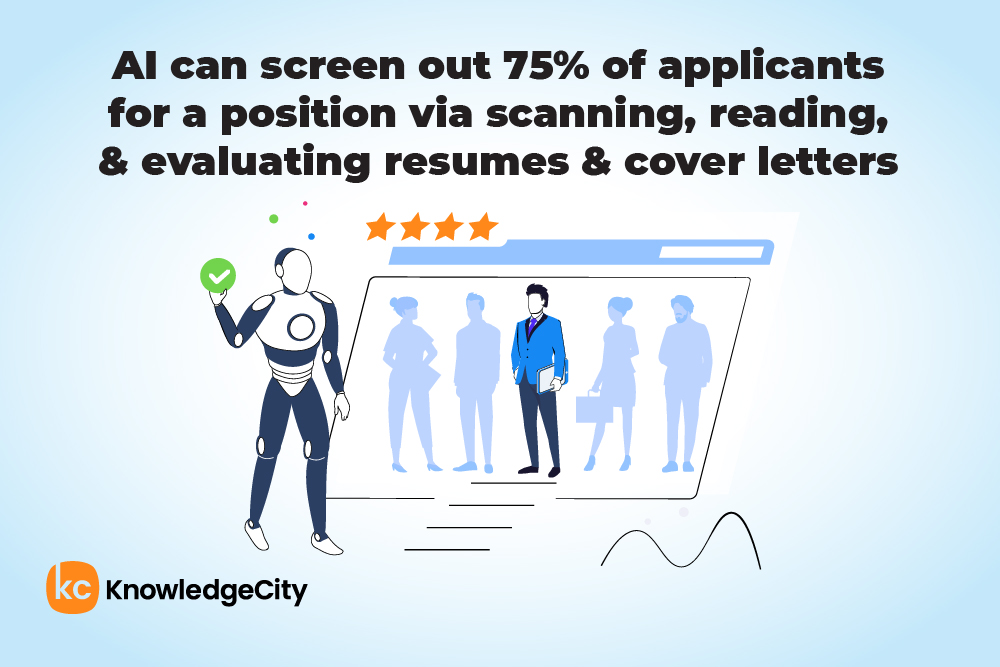For Human Resources (HR) departments, the strain of being responsible for the number of different tasks involved in their field can be considerable. Many of these tasks are repetitive and data driven, and seem to continue to pile up as the year goes on. In finding ways to reduce some of this workload, the use of Artificial Intelligence (AI) in HR can feel like a perfect fit.

For a majority of companies, AI is already being used in talent acquisition, with some 64% of HR professionals noting that their companies’ automation or AI tools are already screening out unqualified candidates from recruiting.
Using AI to knock out tasks that take up significant amounts of time, but don’t require distinctly human input, is one of the many benefits of using it in HR. While it’s already having immediate impact for some companies and long-term potential for others, there are limitations to the technology. They may not be immediately obvious, but a company using AI should still address those limitations.
How is AI Used in Human Resources?
Ask any long-term HR employee what really upsets them about their day-to-day and they’ll probably tell you that it’s the time-consuming, repetitive tasks. But AI is changing the way automation works across nearly every industry, with tremendous benefits. For HR professionals, this includes shifting the responsibility of time-intensive tasks like:
Payroll processing. How many times has an error from a single employee resulted in chaos for everyone else on payday? AI can reduce human error and quickly calculate and keep track of every employee’s unique set of holdings, 401(k) contributions, and other unique payroll criteria. Different payment schedules are a snap with this technology.
Benefits administration. One of the first applications for AI in HR is managing benefits, which includes making updates or changes to healthcare selections and altering 401(k) choices. It also involves adding and subtracting beneficiaries, tabulating paid time off, and other tasks that can easily be automated and repeated throughout the year.
Performance management. Every employer would like to trust that their employees are consistently giving their all, but that’s just not reality. Using AI-powered monitoring software not only lets companies monitor their employees, but also can keep them on the alert for bottlenecks and stoppages that come from a lack of harmony in the workflow.
Monitoring emails, intranet activity, and chat messages can help ascertain if an employee is feeling underappreciated, exhausted, disengaged, or even performing an activity that’s counter-productive or against employee regulations.
How HR is Using AI in Recruitment and Onboarding
There are few sunk costs as well known in business as hiring a new employee when another one leaves. The total costs of compiling advertisements for a position, recruiting, interviewing, benefits, the salary, and the new hire’s onboarding can add up. It can take six months past the new employee’s start date for them to begin contributing positively to the company’s revenue.
Integrating AI into HR recruitment and onboarding can cut costs from the bottom line. It can also free up vital time for HR staff to handle more complex tasks.
It’s not just about finding new candidates, however. AI can crunch the hard data and reasonably predict when companies will need to start looking for replacements at current positions or for talent to fill jobs that are likely to be necessary in the future.
When those positions need to be filled, AI systems like Open AI’s ChatGPT can be used to generate custom job descriptions. These are then distributed through the company’s social media channels, intranet, and traditional job sites, focusing on the ones most likely to produce worthwhile candidates.
Organizations are trying to leave the days of painstaking recruitment portals behind in exchange for machine-powered communications that follow a sequence based on what the company is looking for and what it finds in a candidate’s submissions.
According to research, AI can screen out 75% of applicants for a given position based solely on scanning, reading, and evaluating resumes and cover letters, drastically reducing the time needed from actual HR employees.
AI can do even more than just weeding out the candidates that don’t fit the bill. It’s able to use scoring and ranking technology to quickly filter applicants into tiers that organize them by how viable a candidate they are.
For more technical-based jobs, it can even administer tests in online portals to ensure that applicants have the necessary hard skill sets needed to perform the job.
While most interviews still need that definitive human touch, companies using AI in HR will continue innovating the technology as a start-to-finish solution, including with the onboarding of new employees.
Sometimes, onboarding new employees can feel a lot like hand holding, through the first few days of their employment in particular. It’s necessary to do everything by the book to get a new employee in the system and ready to go. But the process is monotonous and usually doesn’t need someone’s physical presence.
Companies can use AI to verify necessary documents, provide access to digital resources like software and cloud access, and move employees through all compliance training to successfully begin work. AI does the heavy lifting on data processing, compliance, and financials, leaving the HR professionals able to sign off on documentation after making sure there are no glitches.
The number of companies using AI in HR is increasing at a rapid pace, with 92% of HR leaders polled saying they plan on using AI in the near future to acquire talent.
Companies Using AI in HR
Some of these scenarios might sound more like a forecast than a current reality, but the truth is there are plenty of companies that aren’t waiting to have someone else take the first crack at using AI in HR recruitment.
One of those is multinational brand Unilever, which has products in more than 190 countries and more than 169,000 employees worldwide. Unilever employed HireVue, an AI-designed hiring platform, to deploy its algorithm for identifying strong candidates for certain positions.
A case study that HireVue published indicated that Unilever dropped its hiring time by 90% over the course of a project that was designed to hire 800 employees out of a staggering 250,000 applications. HireVue’s AI filtered 80% of the 250,000 candidates using a points system that assessed which ones would be the most successful based on the company’s ideal candidate profile.
A few specific questions asked through a chatbot conversation allows candidates to feel like they have a real say in the process while allowing HR professionals to succinctly gather a pool of top candidates. They don’t have to track down each of them, arrange a phone or video call, sit through the call, and file the collected data.
With machine learning allowing chatbots to have realistic conversations, companies like Hays, Deloitte, and Adecco save a significant amount of time.
Benefits and Drawbacks of Using AI in HR
Quantifying the benefits of employing artificial intelligence in HR is a fairly straightforward process. Already 85% of employers using AI say it saves time and/or ramps up efficiency.
Considering that time can’t be replenished, that’s the most significant advantage AI brings to the table. But the HR benefits stretch well beyond that. Through advanced analytics, AI empowers HR managers to solve problems and make decisions using real-time data analysis that can be easily visualized to ensure the best moves are being made.
Using AI to correctly assess employee sentiment through natural language processing of emails, chats, and messaging can help companies reduce employee turnover. It works by identifying unhealthy situations and attitudes and suggesting plans of action to get them headed back in the right direction.
Another positive example of how AI is used in Human Resources is in the field of learning and development. Employees may suffer from lack of interest and screen fatigue when they have to go through one online course after another, whether it’s for compliance’s sake or to integrate new skill sets.
Retention rates can be significantly improved by using AI to gamify the process, and to identify what sort of learning courses might best engage an employee based on their known interests.
Of course, there’s a downside for every new integration into the workplace, and artificial intelligence is no exception. While the use of AI in HR statistics is favorable, the technology isn’t perfect and shouldn’t be treated as the end-all be-all of HR practices.
For instance, a Harvard Business School survey found that 88% of HR executives have experienced their AI-driven systems rejecting candidates that were actually qualified for the positions they applied for. AI should be considered a tool for helping make good decisions, not as the final word in your HR department.
For all its ability to parse data and recognize patterns at the speed of thought, at the end of the day, AI remains an invention with blind spots and errors.
What to Consider When Adopting AI
Though AI is rapidly becoming part of many organization’s HR departments, give it careful consideration before adopting it for yours. Just like any other automation tool that’s marketed to companies as a one-stop shop for all their problems, it’s best to administer a healthy dose of reality.
Any AI tool claiming it can automate all of a company’s HR needs is likely suffering from an ego trip. AI should enhance what your company is already doing, not replace it completely.
Another consideration to weigh is how effective your cybersecurity and data security are. The more weight that AI carries in any organization, the more potential damage hackers and cybercriminals can do if they were to break into your AI’s database.
It’s also worth considering whether adopting AI is worth the time and cost. Per Forbes, it can be costly to try to adopt AI without the resources and familiarity to do so. Also, implementing AI may require investing in expensive technologies and updating current systems.
Conclusion
There’s always uncertainty when AI and automation start to gain mainstream acceptance into any field of business. People will become afraid that they’ll lose their jobs when their company transitions from a human-centric workspace to one where AI is suddenly handling a significant share of the number crunching and other tasks.
It’s possible that many human tasks will vanish in a cloud of AI-powered automation, which could mean that a total reorganization of the HR department is inevitable. However, losing one type of job is likely to coincide with a new landscape of positions opening up and becoming rapidly more important, namely for employees with strong skills in the STEM (science, technology, engineering, and mathematics) fields.
The ability to harness AI and gain actionable insights from the data it collects and analyzes will be vital to stay ahead of the competition. This includes putting AI to work in tasks such as finding the best workforce candidates to take over for departing employees. Incorporating AI into Human Resources could mean that the HR department isn’t as top heavy, with one person tasked with making every major decision.
Rather, it will become a more balanced business unit where multiple managers are in place to use AI for making decisions on positions, employees, and responsibilities. This will phase out the need to place all of the decision-making responsibility on one person. AI will give more HR professionals the opportunity to do vital work in less time with more knowledge at their fingertips.
Subscribe to Our Newsletter
Join 80,000+ Fellow HR Professionals. Get expert recruiting and training tips straight
to your inbox, and become a better HR manager.

 Nick Georgandis
Nick Georgandis 


